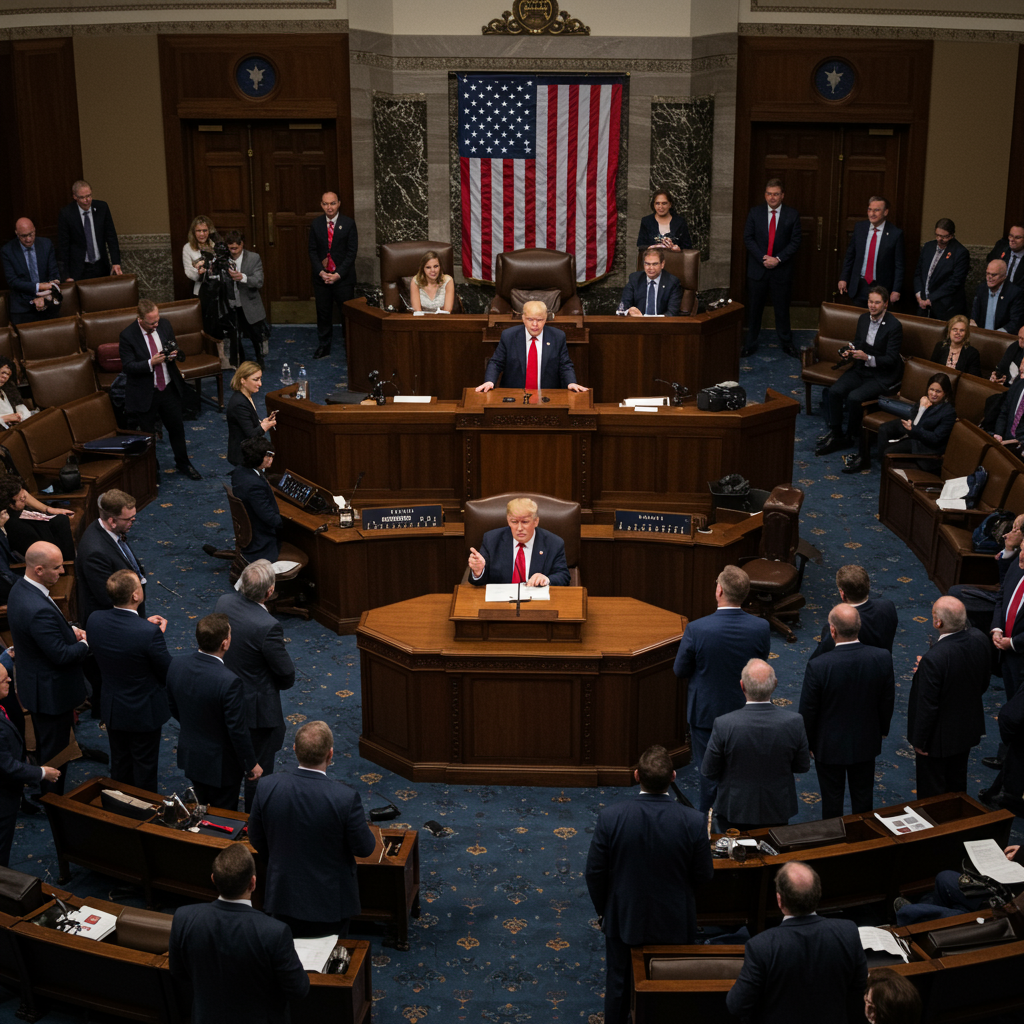A high-stakes legislative battle is unfolding in the U.S. senate. At its center is a massive budget package. This bill is central to President Donald Trump’s potential second-term agenda. Republicans are pushing hard to pass it. They face a self-imposed July 4th deadline. However, the bill is facing significant opposition. The opposition comes from within the Republican party itself.
The sprawling measure combines vast tax cuts with deep spending reductions. It passed the house of Representatives last month. The margin was incredibly narrow. It succeeded by just a single vote. Now, the Senate is taking up the bill. The latest version is a daunting 940 pages. It was released shortly after midnight Saturday.
The High Stakes: Trump’s Agenda and the July 4th Deadline
President Trump has dubbed this package his “big, beautiful bill.” It represents a key priority for his administration. Passing it before the July 4th recess is seen as urgent. Republican leadership aimed for an initial procedural vote on Saturday. This would advance the bill to the Senate floor.
Senate Majority Leader John Thune acknowledged the ambitious timeline. He described plans for a Saturday vote as merely “aspirational.” The urgency stems from several factors. Extending tax cuts passed in 2017 is a major driver. Many of these cuts are set to expire soon. The bill is also viewed as an opportunity to raise the debt ceiling. Republicans prefer to do this without Democratic support. Speaker Mike Johnson visited the Senate recently. He urged senators to make minimal changes. This reflected the delicate balance needed in the House.
Inside the Divisions: Why Republicans Are Holding Out
Despite the push from leadership, key Republican senators have voiced objections. Their concerns touch on specific provisions. These divisions highlight fundamental disagreements. They exist within the GOP caucus itself. The bill requires a simple majority to pass the Senate. Republicans hold 53 seats out of 100. This includes Vice President JD Vance’s tie-breaking vote. They can afford only three defections. As of Saturday, at least three senators had expressed opposition.
Fiscal Hawks Demand Deeper Spending Cuts
One faction of Republicans demands more aggressive spending cuts. They believe the bill doesn’t go far enough. Senator Rand Paul of Kentucky is a vocal critic. He argues the bill would “explode the debt.” Non-partisan analyses support concerns about the national debt. The Congressional Budget Office (CBO) estimates the House version increases the debt by $3.1 trillion. This includes interest costs.
Other fiscal conservatives share this view. Senator Ron Johnson of Wisconsin called the proposed cuts “not squat.” Senator Rick Scott of Florida agreed the cuts are insufficient. Senators Roger Marshall and Ted Cruz aim for even deeper reductions. They target a $2 trillion goal. Senator John Kennedy supports cutting “until we run out of votes.” Achieving such steep cuts is politically challenging. It often requires targeting politically sensitive programs. This includes Medicare, Social Security, or defense.
Protecting Medicaid: Moderate Senators’ Concerns
Another point of major contention involves Medicaid. Moderate Republicans are concerned about proposed changes. This program covers millions of low-income Americans. Senators Susan Collins of Maine and Lisa Murkowski of Alaska are particularly watchful. They previously tried to remove language suggesting $880 billion in Medicaid cuts. Senator Josh Hawley of Missouri also opposes potential cuts. He called them “morally wrong and politically suicidal.”
The bill includes new work requirements. These would apply to childless adults. They would need to work 80 hours per month. More frequent eligibility checks are also proposed. The Senate version is considering even stricter work rules. This includes parents with older children. There are also concerns about state Medicaid provider taxes. The bill could penalize states using these taxes. Hawley worries this could close rural hospitals. Experts suggest finding $880 billion in savings without structural changes is impossible. Such changes would likely reduce benefits. The CBO estimates Medicaid cuts could leave 7.8 million people uninsured. Democrats have heavily criticized this aspect. Senator Patty Murray called it “the largest healthcare cuts in history.”
The SALT Cap Showdown: Blue-State Republicans Weigh In
The State and Local Tax (SALT) deduction is another battleground. The 2017 tax law capped this deduction at $10,000. Blue-state Republicans represent constituents in high-tax areas. Lifting or raising this cap is critical for their votes. The House bill raised the cap to $40,000. This applied to married couples earning up to $500,000.
Senate Republicans are less affected by this cap. Many oppose raising it significantly. Senator Ron Johnson favors eliminating it entirely. Senator Kevin Cramer suggested halving the proposed increase. Speaker Johnson warned against altering the SALT provision. He said it could jeopardize House passage. Senator Markwayne Mullin vowed not to touch the SALT cap issue. Raising the cap adds significantly to the bill’s cost. This puts blue-state Republicans at odds with fiscal conservatives. The latest Senate version matches the $40,000 House increase. However, reports indicate it would expire after five years. It would then revert to $10,000.
Clean Energy Credits Become a Flashpoint
The bill proposes phasing out tax credits. These credits support clean energy projects. They were part of the Inflation Reduction Act. This proposal faces opposition from some senators. Senators Murkowski, John Curtis, Jerry Moran, and Thom Tillis raised concerns. They argued against a full repeal. They cited potential disruptions to the energy industry. They also mentioned impacts on U.S. global energy leadership. Tillis emphasized protecting businesses with “stranded costs.” Conversely, Senator Ron Johnson supports eliminating these credits completely. Elon Musk also criticized the bill on X. He took issue with proposed taxes on solar and wind energy projects. He argued it would harm the economy and cause “immense strategic harms.”
Debt Ceiling Dilemma: Debate Over Borrowing Limits
The package includes an increase in the U.S. debt ceiling. The limit on government borrowing would rise. The House bill proposed a $4 trillion increase. The Senate version suggests $5 trillion. Fiscal conservatives oppose such a large hike. Senator Rand Paul is strongly against it. He argues it is not “fiscally conservative.” He feels the GOP would “own the debt.” Paul proposes removing the debt ceiling increase from the bill. He prefers a separate, short-term vote. This would require verifying spending cuts first. Senator Ron Johnson also supports splitting the package. He favors a smaller, short-term extension.
Key Provisions: What’s Actually in the Bill
Despite the disagreements, the bill contains core components. It reflects a mix of extended and new tax cuts. It also proposes significant changes to major spending programs.
Tax Cuts: Extending 2017 and Adding New Ones
A primary objective is extending the 2017 tax cuts. These are set to expire. The bill also includes new tax cuts Trump campaigned on. This includes a tax deduction on Social Security benefits. It also aims to eliminate taxes on overtime work and tips. The Senate version proposes phasing out the tip/overtime deduction based on income. The House bill included a temporary standard deduction increase for older Americans. The Senate is considering a larger, permanent deduction.
Spending Reforms: Medicaid and SNAP
Major reforms target Medicaid and SNAP. Medicaid changes include work requirements for childless adults. More frequent eligibility checks are planned. The Senate version adds stricter work requirements for adults with older children. It also seeks to lower state Medicaid provider taxes over time. However, it delays these cuts. A $25 billion rural hospital fund is included. This addresses concerns from states.
SNAP (Supplemental Nutrition Assistance Program) faces proposed changes. States would be required to contribute more funding. This program is currently federally funded for benefits. Work requirements for able-bodied enrollees without dependents are also included. The latest Senate version temporarily exempts Alaska and Hawaii. This addresses concerns from their senators.
Other Notable Changes
The bill includes other adjustments. Funding for rural hospitals was increased. This appeased some moderate senators. Changes were made to the SALT deduction cap. The $40,000 limit for married couples earning up to $500,000 aligns with the House. But the Senate version reportedly ends this after five years. The Child Tax Credit is also addressed. The House voted to increase it through 2028. It requires SSNs for both parents. The Senate is considering a slightly smaller, permanent increase. It would require only one parent SSN.
The Procedural Path Forward
The immediate step is a procedural vote in the Senate. If this passes, the bill moves to the floor. There, it can be debated. Further revisions can potentially be made. A final successful vote in the Senate is needed next. If it passes, it returns to the House of Representatives. The House must consider the changes made by the Senate. They would then vote again. If the House approves, it goes to President Trump’s desk. He can sign it into law. The process highlights the significant hurdles remaining. Compromises will be necessary. The outcome remains uncertain. It hinges on navigating the internal Republican divisions.
What Critics Are Saying
Opposition to the bill is strong. Democrats universally oppose the package. They particularly target the proposed cuts to Medicaid and SNAP. They argue it would limit healthcare access. Non-partisan groups raise concerns about the debt impact. Elon Musk criticized the clean energy tax proposals. He warned of negative economic consequences. House Minority Leader Hakeem Jeffries called the House version a “reckless, regressive and reprehensible GOP tax scam.” The blend of large tax cuts and significant program reductions fuels intense political debate.
Frequently Asked Questions
What are the key tax cut and spending cut proposals in the Republican budget bill?
The bill aims to extend significant tax cuts from 2017. It adds new cuts championed by President Trump. These include eliminating taxes on overtime and tips. It also proposes a deduction on Social Security benefits. To help pay for these cuts, the bill includes substantial spending reductions. These target programs like Medicaid and SNAP. Proposed changes include work requirements for recipients and shifts in funding responsibility.
Why are some Republican senators opposing the bill?
Republican opposition stems from several specific concerns. Fiscal conservatives argue the bill doesn’t cut spending deeply enough. They worry about increasing the national debt. Moderate senators are concerned about proposed cuts to Medicaid. They fear it could harm vulnerable populations and rural hospitals. Senators from high-tax states oppose the $10,000 cap on the SALT deduction. They want it raised significantly. There are also disagreements over proposed changes to clean energy tax credits and the size of the debt ceiling increase.
What happens next if the Senate passes the bill?
If the Senate successfully passes the bill, including a potential initial procedural vote and a final vote, the legislative process continues. Because the Senate is expected to make changes to the version passed by the House, the modified bill must then return to the House of Representatives. The House will review the Senate’s changes and vote on the revised package. If the House approves the bill as amended by the Senate, it will then be sent to President Trump’s desk for his signature or veto.
Conclusion
The Republican budget bill represents a critical test. It challenges the party’s ability to unify behind a major legislative goal. The blend of ambitious tax cuts and controversial spending reforms has exposed deep internal rifts. Fiscal conservatives, moderates worried about social programs, and members concerned with state-specific issues like the SALT cap all hold leverage. Navigating these conflicting demands before the July 4th deadline will require difficult compromises. The future of the bill, and with it a core piece of President Trump’s agenda, remains uncertain. The narrow margins in both chambers mean every vote is critical. The legislative process promises further debate and potential revisions.



